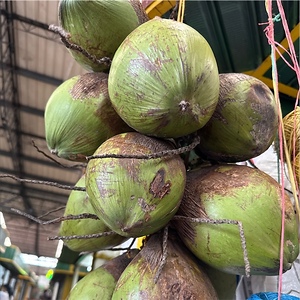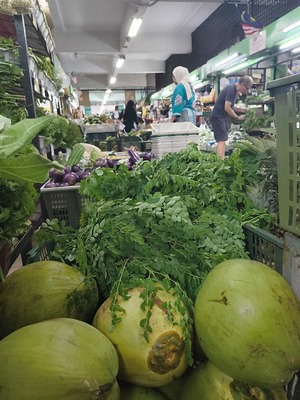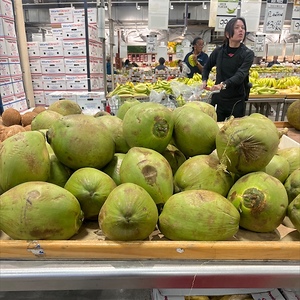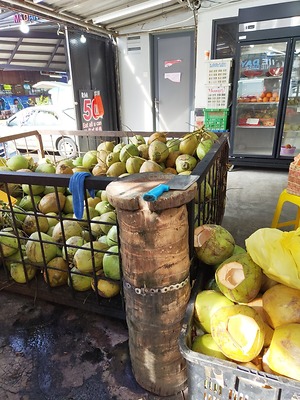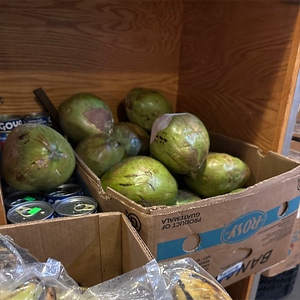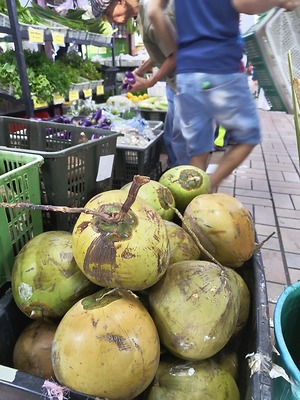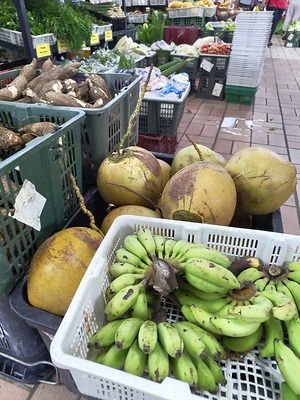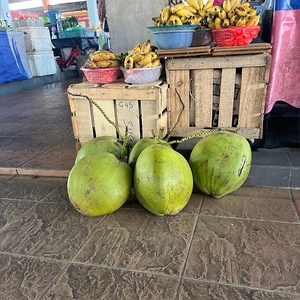

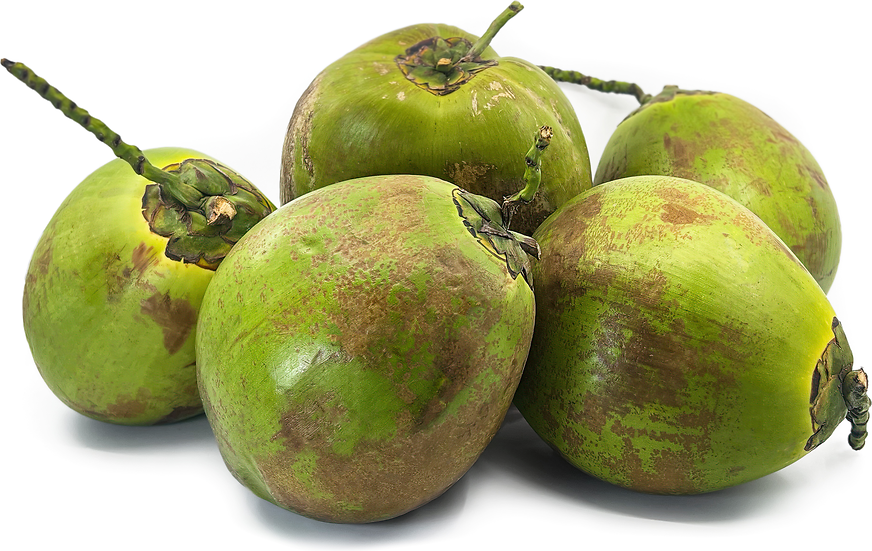
Green Coconuts
Estimated Inventory, lb : 0
Description/Taste
Green coconuts are medium to large in size, averaging 30 to 33 centimeters in length, and have a round to elliptical shape with blunt, curved ends. The top of the fruit is capped with a green stem, and the exterior, also known as the exocarp, is smooth, firm, and taut with a springy feel. When squeezed, the exocarp should give slightly and is generally a light to olive green hue. Underneath the exocarp, there is a white-to-ivory, fibrous husk encasing a central chamber filled with water and a thin layer of flesh. Younger Green coconuts may not have any developed flesh and will only contain water when opened. Slightly more mature Green coconuts will have a layer of jelly-like flesh that can be easily scooped from the coconut with a spoon. The white flesh has a viscous nature and is soft, rich, tender, and succulent. Green coconuts should feel heavy for their size and will have a sloshing sound when shaken. Select Green coconuts that are free from cracks, mold, and wet spots, and the entire fruit should be unopened. Green coconuts taste mildly sweet, refreshing, nutty, and subtly tart.
Seasons/Availability
Green coconuts are available year-round.
Current Facts
Green coconuts, botanically classified as Cocos nucifera, are the young fruits of the coconut palm, belonging to the Arecaceae family. Coconuts, in general, are challenging to categorize as botanists refer to them as a fruit, seed, drupe, and nut. Green coconuts are the youngest version of the fruit and are typically picked after 7 months of growing on the tree. At this stage, the fruits are generally full grown in size but have not reached complete maturity. They also have a green exterior and are filled with approximately 11 ounces of water. Coconuts fully mature around 12 months on the tree, and at this stage, they have transitioned into a dark brown coloring with more meat and little water. Green coconuts are revered for their water content and contain the highest amount of water out of all the fruit stages. The young fruits also have a thin layer of soft flesh, depending on maturity, that is edible and consumed as a snack. Green coconuts are also known as Young coconuts, Water coconuts, and Green Water coconuts. In commercial markets, Green coconuts are sold whole and unopened. The large fruits are seen stacked in large piles throughout tropical to subtropical regions worldwide and are sold and opened as a refreshing, hydrating beverage.
Nutritional Value
Green coconuts are a source of phosphorus to help the kidneys filter out waste, calcium to build strong bones and teeth, vitamin C to boost the immune system, and potassium to balance fluid levels within the body. The coconuts also provide iron to develop the protein hemoglobin for oxygen transport through the bloodstream, magnesium to control nerves, vitamin E to reduce inflammation, antioxidants to protect the cells against the damage caused by free radicals, and other nutrients, including zinc, selenium, manganese, vitamin K, and copper. Beyond vitamins and minerals, Green coconuts contain electrolytes that help the body stay hydrated. Green coconut water is rich in nutrients to replenish and balance the body after sweating and is a natural remedy for dehydration.
Applications
Green coconuts are primarily used for their high water content. The mildly sweet and nutty liquid can be enjoyed straight from the fruit, and the water is pure and a source of electrolytes. Residents in tropical climates often consume coconut water as a natural hydration source, and Green coconuts are typically chilled to create a refreshing beverage. Green coconut water can also be blended into smoothies, mixed into fruit juices, or stirred into cocktails. In Southeast Asia, coconut water is occasionally used in curries, sauces, and dressings. In addition to the water, Green coconuts have a thin, soft, and jelly-like layer of flesh, depending on maturity, and this flesh can be scraped from the sides of the coconut with a spoon. The flesh can also be added to puddings, yogurt, ice cream, and jellies or incorporated into desserts such as pies, custards, and cakes. Whole Green coconuts will keep unopened for 1 to 2 weeks in a cool and dark location. Once opened, the flesh and water should be immediately consumed, lasting only 2 to 3 days in the fridge.
Ethnic/Cultural Info
In Samoa, Coconut palms are famous in a story of love, anger, and death. Legend has it that in the tale of Sina and the Eel, also referred to as Sina Ma Le Tuna, there was a young girl named Sina who was known across the land for her beauty. One day, Sina found a small eel and carried it home as a pet. The eel grew larger and larger, and as it grew, it fell in love with Sina. The eel also became angered quickly and often lashed out at Sina. Sina became afraid and fled to Moata’a, a village now known as Taumeasina in Samoa. Sina eventually relaxed in Moata’a, thinking she had finally escaped the eel, but suddenly, she noticed two eyes staring up at her in the village’s shared watering hole. Sina cried out in fright, and the village chiefs rescued her, killing the eel. As the eel was dying, its last request was to be buried in Moata’a to be near Sina. Sina acquiesced to the eel’s request and buried its head beside her home. The next day, when Sina visited the grave, she noticed a new tree had sprouted from the burial spot. The tree produced large fruits with three distinct round marks on the surface when opened, resembling the eel’s eyes and mouth. The village revered the new tree and fruits, and it was discovered that the head-like fruits contained water and flesh, becoming a life-giving nutrient source. It is also said the eel got its ultimate wish of loving Sina, as every time Sina drank from the fruits, she kissed the head of the eel. Sina and the Eel is an ancient Samoan legend, but the story has been passed between generations, spreading across Polynesia and becoming a widespread folk tale into the present day. There is also a famous resort in Samoa named after the heroin known as Taumeasina, meaning “landing place of Sina.” Since its spread across Polynesia, there are many variations of Sina and the Eel, including one that claims the King of Fiji turns himself into an eel to be close to Sina.
Geography/History
Coconut palms, Cocos nucifera, are thought to have originated in India and Southeast Asia and have been growing wild since ancient times. Coconuts spread naturally by dropping from the palms and floating across ocean currents, eventually sprouting and forming new trees in tropical to subtropical regions. Human civilizations also began spreading the palms by carrying coconuts on long journeys. Excess coconuts were planted and allowed to grow into trees along trade routes and in coastal ports. The trees were determined as a valuable source of food, water, and construction materials. Coconut palms have become naturalized in tropical to subtropical regions worldwide. They are found in a band around the equator approximately 25 degrees north and 25 degrees south. The palms thrive in aerated, sandy, draining soil and are typically found in humid climates with access to fresh water. Today, Green coconuts are sold in areas prevalent with coconut palms and are a specialty item. In countries with tropical climates, Green coconuts can be seen stacked in large piles at fresh markets and outside of restaurants and are sold as a refreshing beverage. Select grocers worldwide also seasonally stock the coconuts and sell them whole in their natural state.



